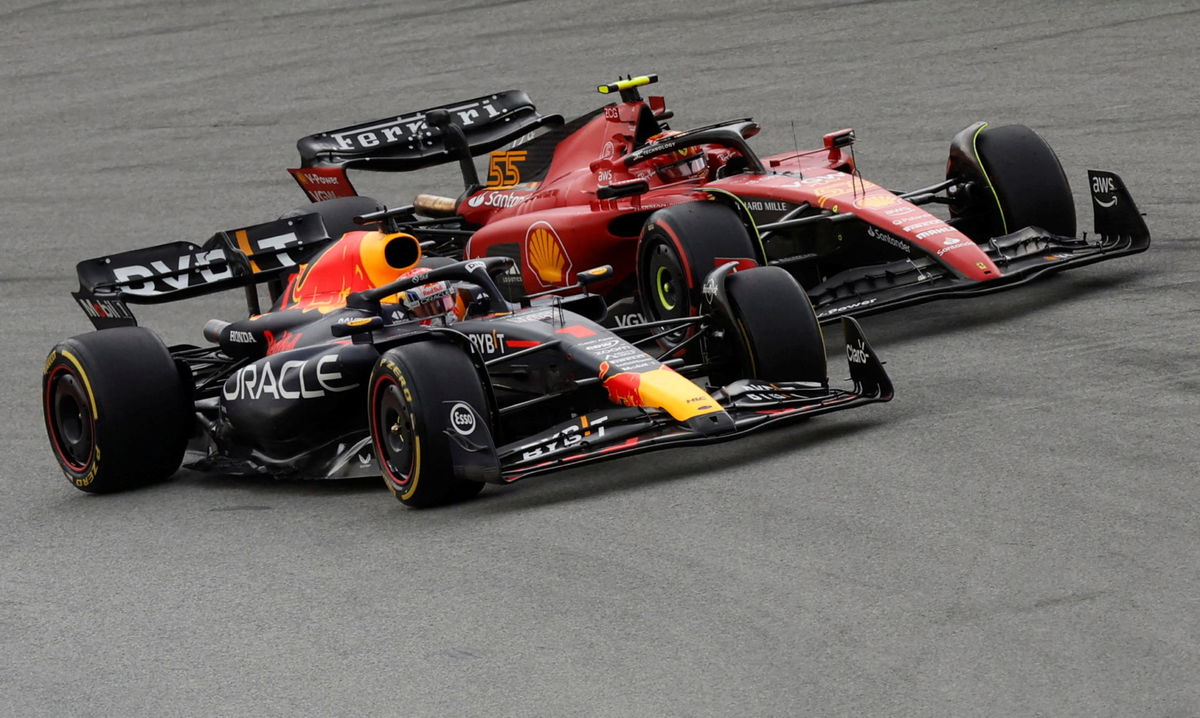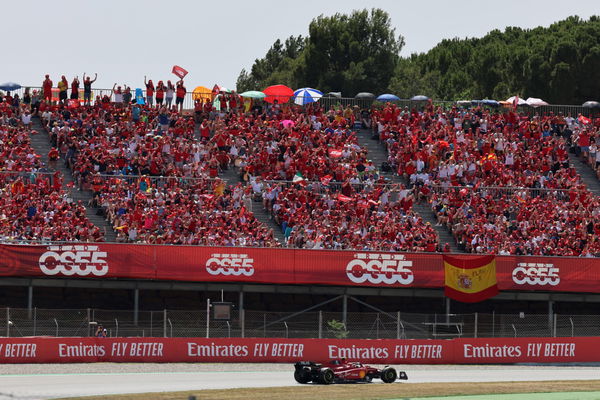
Reuters
Formula One F1 – Spanish Grand Prix – Circuit de Barcelona-Catalunya, Barcelona, Spain – June 4, 2023 Red Bull’s Max Verstappen in action as he leads into the first corner at start of the race ahead of Ferrari’s Carlos Sainz Jr. REUTERS/Albert Gea TPX IMAGES OF THE DAY

Reuters
Formula One F1 – Spanish Grand Prix – Circuit de Barcelona-Catalunya, Barcelona, Spain – June 4, 2023 Red Bull’s Max Verstappen in action as he leads into the first corner at start of the race ahead of Ferrari’s Carlos Sainz Jr. REUTERS/Albert Gea TPX IMAGES OF THE DAY
The popular Barcelona Vs Madrid battle in the world of soccer has reached Formula 1 as well, and Madrid has won this El Clásico. We are talking about the recent announcement of the city of Madrid securing the hosting rights for the Spanish GP from 2026 onwards. The track will be right in the middle of the city which will give it unique features. Madrid snatched the ball from Barcelona despite a valid contract till 2026, as a regular fixture on the calendar will get a new home.
Watch What’s Trending Now!
However, we wonder if the new home will successfully fulfill the duties of hosting the Spanish GP after the Circuit de Barcelona-Catalunya served for over 30 years. Because of the nature of the track, the sudden announcement, and F1’s preference for a certain type of track, there is a lot of discussion on the matter. Let us also give you our perspective and compare the two tracks. First, let’s talk about the new host.
ADVERTISEMENT
What does the new home of Spanish GP–Madrid–have to offer?
First, let us tell you the details of the deal and the track. As we all know, the brand-new track will host its first race in 2026, as most rumors suggested, and is contracted till 2035. The track will be built around the world-class IFEMA exhibition center and will span across 3.40 miles. The track will feature a whopping 20 corners, subject to FIA homologation and final design specification. The projected time around the track is at 1 minute 32 seconds.
The track is also projected to host a massive 110,000 per day. The capacity, as per the deal, will be increased to 140,000 per day over the first half of the agreement. This capacity will make Madrid one of the biggest venues on the calendar. The new Madrid circuit will also be the most unique circuit for three reasons.
Top Stories
“Have Some Shame”- Fans Tear Apart F1 Pundits’ Shocking 2025 Driver Ranking

Just 2 Days After Scoring His First Podium in 14 Months, Lando Norris Exposes Biggest Chink in McLaren’s Armour

Who Is Canadian F1 Billionaire Lawrence Stroll’s Daughter & Heiress Chloe Stroll?

Max Verstappen Takes a Cheeky Dig at His Father Jos Verstappen for Spoiling Mum Sophie’s Racing Talent

“Max Is Nothing Special”: Verstappen’s Success Shot Down to RB-19’s Cutting Edge as Fans Get Behind 2 F1 Stars to Beat Him in Equal Machinery


Reuters
Formula One F1 – Spanish Grand Prix – Circuit de Barcelona-Catalunya, Barcelona, Spain – May 22, 2022. Mercedes’ George Russell, Red Bull’s Sergio Perez and Red Bull’s Max Verstappen in action during the race. REUTERS/Albert Gea
First: Perhaps the most important feature to all fans, the new Madrid circuit will be a hybrid track. Parts of the track will be reminiscent of a traditional F1 track, while parts of the track will feature a street track. Madrid joins the growing list of street tracks that already feature on the calendar. If you have any doubts about the sport’s growing obsession with street tracks, here’s more proof!
ADVERTISEMENT
Second: The shared vision for F1’s Net Zero Carbon emission by 2030. IFEMA Madrid shares this vision and plans to make the Spanish GP one of the most sustainable F1 races of the season. IFEMA has already reduced its carbon emissions over the last five years and moved to 100% certified renewable energy across all exhibition halls. The efforts will extend to creating all temporary structures with recyclable materials.
ADVERTISEMENT
Third: Perhaps the most important feature of the track for locals and every fan making the trip for the race weekend, the Madrid circuit will become one of the most accessible venues on the calendar. The circuit will be 5 minutes away from the Madrid-Barajas Adolfo Suarez airport. Adding to this convenience, it is predicted that 90% of the fans will be able to access the circuit via public transport or a brief walk from local accommodations.
Read More: F1 News: 2 Days Before Rumored Mega Madrid GP Announcement, Spain’s Political Friction Endangers F1
In addition, the race will also create 8200 new jobs and even contribute 490 million dollars to Madrid’s GDP per year. This is close to $5 billion over the track’s contract, valid till 2035. However, we still need to discuss the crux of the matter. Will it be a better track for racing compared to Circuit de Barcelona-Catalunya?
ADVERTISEMENT
Will the shiny new Madrid track be better than Barcelona for racing?
There is no doubt the Madrid track will attract more fans and it will house 140,000 fans after the expansion. The Circuit de Barcelona-Catalunya already has a capacity of 140,700 and has been hosting races almost every year for over 30 years since 1991. Moreover, Barcelona is the favored track for winter testing as well for all teams. It’s a good all-rounder of a circuit, with low, medium, and high-speed corners to negotiate–making it such a good test track. However, this is where the problem lies.
Because of its regularity in the last three decades, the Barcelona circuit has lost its charm and the sense of unpredictability. Most drivers on the grid can maneuver the track in their sleep. Apart from the home support for our two Spaniards Carlos Sainz and Fernando Alonso, the track now lacks enthusiasm from the drivers with minimal overtaking. This translates to boring and predictable races, although not always. The track has witnessed some incredible races!
ADVERTISEMENT

Reuters
Formula One F1 – Spanish Grand Prix – Circuit de Barcelona-Catalunya, Barcelona, Spain – May 22, 2022 Ferrari’s Carlos Sainz Jr. in action as spectators look on during the race REUTERS/Nacho Doce
Because of the familiar nature of the track, we do see the drivers push their machines to the limit with the mix of high and medium-speed corners, making for an enthralling spectacle for the fans. This is why we still hope Barcelona has a future in the sport and Madrid doesn’t make the storied and historic circuit redundant.
F1 CEO, Stefano Domenicali put some faith into the idea by saying, “Looking ahead, there are discussions in place to see if we can really extend our collaboration with Barcelona, with whom we have a very good relationship, for the future,” while addressing the media after the Madrid announcement as reported by Formula1.com.
ADVERTISEMENT
WATCH THIS STORY: Will F1 Bring Back the South African GP at Kyalami to the Calendar?
Madrid will be a completely different track with its hybrid nature, so until it hosts a race or two, no one can predict the nature of the racing in the new Spanish GP home. For our sake, as fans, let’s hope it proves to be an exciting track to race on. After all, it will host races for 10 years. So without completely discounting Barcelona, we are excited to see Madrid host the 2026 Spanish GP.
Editorial Disclaimer: The views expressed are those of the author and do not necessarily reflect the opinions of EssentiallySports.
ADVERTISEMENT
ADVERTISEMENT
ADVERTISEMENT
ADVERTISEMENT

